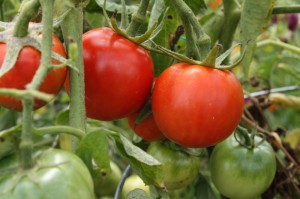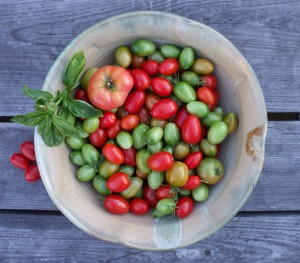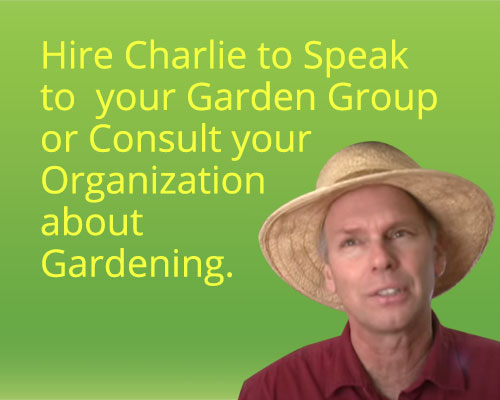Listen to this great story about an heirloom tomato variety and how it got to be so popular.
Listen to Podcast:
How to Grow: Tomatoes
It’s hard to image a vegetable garden without tomatoes (Lycopersicon esculentum). They are t he number one grown vegetable in gardens and there are hundreds of hybrid and heirloom varieties to give you more selections than you can think of. There are white, black, green,
he number one grown vegetable in gardens and there are hundreds of hybrid and heirloom varieties to give you more selections than you can think of. There are white, black, green,
red, pink, orange, yellow, purple, and striped colored varieties. Some grow as large as 7 pounds while others are as small as a cherry. Some plants are as small as 1 foot tall and others grow to 7 feet tall. Regardless of which variety you grow, home grown tomatoes just taste better. The flavor is sweet and juicy, so different than a store bought variety. Plus, they’re loaded with vitamins, minerals and anti-oxidants.
I like growing a mix of tried-and-true hybrids along with some special colored and flavored heirlooms. I’m always at a loss for space when it comes to tomatoes. I’m like a kid in a candy shop, looking at all these amazing varieties and only having room to grow a few. So every year I plant a few experimental, heirloom varieties to see how they grow. This is important because heirloom varieties are very regionally adapted. What might grow well in Tennessee or Oklahoma, may not in my Vermont garden. I also check regional seed catalogs and see what they offer. If it can grow in their trial grounds in my climate, it’s worth a shot in my garden.
When deciding what variety to grow, think of the usage. For kids, salads, and general snacking, grow a few cherry tomatoes. For sandwiches and cooking fresh, try some large fruited varieties. For sauces and canning, think plum tomatoes.
When to Plant
Tomatoes love the heat, so don’t rush them into the garden. They’re more tolerant than their cousins, peppers and eggplants, at bouncing back from cool weather, but why strain them. Six to eight weeks before your last frost date, start tomato seedlings indoors. Harden off your plants gradually getting them accustomed to the outdoors and then move your transplants, or ones bought at the local garden center, outdoors, after the last frost date.
Where to Plant
Tomatoes grow best in full sun on fertile, well drained soil. You can also grow dwarf varieties in containers or even window boxes on a deck or patio.
How to Plant
In heavy clay soil, create 8-inch tall raised beds before planting and amend the soil well with compost. Cover the bed or soil with red plastic mulch. The color red has been proven to stimulate more tomato production. It also preheats the soil, keeps it moist, and keeps weed from growing. Poke holes spaced 2- to 3-feet wide in the plastic. If the seedlings are tall and leggy, plant the stem deep in the soil up to the first set of true leaves. If you can’t plant deep, lay the stem horizontally on the soil in a trench and leave the top cluster of leave pointing upward out of the soil. Either way, tomatoes can grow roots from the stems and it will create a bigger root system and stronger growing plant.
Use floating row cover or Wall o Waters (plastic sleeves in a cylinder that you fill with water) to protect the seedlings during cold weather in spring. I’ve used Wall O Waters for years. They release heat when the water chills, keeping the plants inside the cylinder warm. It can protect plants from temperatures down into the low 20Fs. Remove them once the weather warms and plants get large.
Care and Maintenance
Most tomato varieties need to be caged, staked, or supported in some way to keep the fruits off the ground. This will help avoid insects and diseases attacking the fruits and make for easier harvesting. Dwarf varieties that grow only a few feet tall are good for containers and don’t need supporting. After planting decide on your support system. If you use stakes, drive a 7 foot long stake, one foot into the ground, a few inches from the tomato plant. Tie the main tomato stem to the stake with twine or velcro ties. Prune out any suckers (shoots that emerge from the junction of the main stem and side branch), so the plant doesn’t get too big. Metal or wooden cages work best if they’re at least 5 feet tall, anchored well to the ground, sturdy, and have large enough holes to harvest tomatoes through.
Tomatoes love food to grow strong. Add a small handful of an organic fertilizer, such as 5-5-5, around each plant every month after planting. If you haven’t used plastic mulch, add an organic mulch, such as straw, around plants once they get established to keep the soil consistently moist and weeds away.
Tomato also have a number of pests that love to attack them. First, determine if it is a disease or insect attacking the plant. Blossom end rot, where the tip of the tomato fruit rots as it ripens, is caused by a calcium deficiency in the plant due to the fluctuating soil moisture levels. Mulch and water regularly to take care of this problem.
Tomatoes are subject to many diseases. Look for disease resistant varieties when buying plants. You’ll see many letters after some varieties. These are abbreviations for various diseases. At the least, get a variety with fusarium wilt (FW) and verticillium wilt (VW), and tobacco mosaic virus (TMV) resistance. Some diseases, such as late blight, can wipe out an entire crop and spread to others. Wilt, blights, and viruses all can cause so much damage that it will reduce your yields. Beside planting resistant varieties, space plants properly, mulch, clean up plant debris in fall and rotate, not planting tomato-family crops in the same location for 3 years, to slow down disease problems.
Certain insects can be problems, too. Wrap newspaper around plant stems 2 inches above and 1 inch below the soil to ward off cutworms in spring. White flies suck leaf juices and cause the leaves to yellow. Spray insecticidal soap to control them. Handpick hornworms (those big green worms munching on the leaves) before they defoliate the plant. Spray Neem oil to deter Japanese beetles from feeding on leaves or just hand pick them and drop them into a pail of soapy water to kill them.
Harvest
Anywhere from 60 to 90 days after transplanting look for your tomatoes to start turning the mature color for that variety. Harvest when they’re fully colored. In fall, harvest tomatoes before a frost even if they haven’t fully matured. When stored in warm, dark, airy room, the fruits will continue to ripen. If your tomatoes are slow to mature any fruits, a month before your first frost date, remove any new flowers or small fruits. They won’t have time to mature before a frost and take energy away from maturing the other fruits. Don’t remove the foliage, though, because it protects the fruits from getting sunburned.
Additional Information
Some good main season varieties I like to grow include ‘Big Beef Hybrid’ with its red fruits and good disease resistance. ‘Defiant Hybrid’ has red fruits and resistance to the dreaded early and late blight diseases. ‘Brandywine’ is a classic heirloom that comes in pink, red or yellow versions. It has unique potato-shaped leaves and outstanding flavor. ‘Cherokee Purple’ is a large fruited purple heirloom. ‘Green Zebra’ is a tangy tasting, green colored heirloom.
‘Sungold Hybrid’ is a sweet tasting yellow cherry tomato. ‘Black Cherry’ has dark brown colored fruits and an earthy taste. ‘Yellow Pear’ is a unique shaped heirloom. ‘San Marzano’ is a classic Italian heirloom that’s meaty and great for making sauces.
Excepted from Northeast Vegetable and Fruit Gardening book.
Podcast Transcript
I’m Charlie Nardozzi and this is the Vermont Garden Journal on Vermont Public Radio. I love growing heirloom tomatoes. There are varieties in almost all the colors of the rainbow from black to green to pale yellow. Some have potato leafed foliage and others look like fir trees. They all have the unique tomato taste we crave: some sweet as candy and others more intensely flavored. Many of these varieties have stories that are as interesting as their fruits. Here’s a story of one of my favorites.
Back in the 1930’s and 40’s in Logan, West Virginia, there was a man named MC Byles. Times were hard back then, so MC did a number of jobs to get by, from a mechanic to a professional wrestler. He finally settled on starting radiator repair shop at the bottom of one of the big hills in Logan. Business was brisk. The trucks would rumble up the hill, blow their radiators and coast back to MC’s shop. He got the nick name Radiator Charlie.
Now Radiator Charlie liked to grow tomatoes too, but wasn’t satisfied with the varieties in his area. So one year he collected the best ones, planted a circle of 10 tomato varieties outside his repair shop with one variety in the middle. He cross-pollinated them with the variety in the middle, selected the best seedlings and repeated the process for 7 years. He eventually developed a 10 to 12 ounce, red variety that was sweet and juicy: the perfect eating tomato. Charlie’s tomato became popular, so he started selling plants each spring for $1/seedling. That was a lot of money back in 1940. But people would still come from miles around to buy Charlie’s tomato plants. He sold enough tomato seedlings to eventually pay off the mortgage on his radiator repair shop. So to this day, this variety is know as Radiator Charlie’s Mortgage Lifter.



